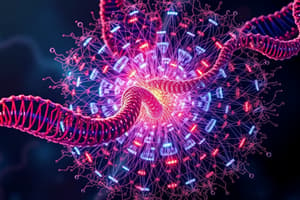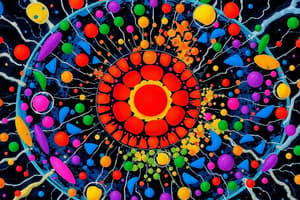Podcast
Questions and Answers
What is the primary function of mitochondria in eukaryotic cells?
What is the primary function of mitochondria in eukaryotic cells?
- Break down fatty acids
- Site of aerobic respiration and ATP synthesis (correct)
- Contains rigid cell membranes
- Forms a double layer of molecules
What characteristic is unique to prokaryotic cells?
What characteristic is unique to prokaryotic cells?
- Single-celled organisms like bacteria (correct)
- Larger and more complex structure
- Contain various organelles including mitochondria
- Presence of membrane-bound nucleus
Which characteristic distinguishes eukaryotic cells from prokaryotic cells?
Which characteristic distinguishes eukaryotic cells from prokaryotic cells?
- Lack of organelles
- Smaller size
- Presence of membrane-bound nucleus (correct)
- Rigid cell membrane
What do phospholipids form in a cell membrane?
What do phospholipids form in a cell membrane?
What does isotonic solution refer to in relation to cell environments?
What does isotonic solution refer to in relation to cell environments?
What is the primary function of lysosomes within the cell?
What is the primary function of lysosomes within the cell?
What role do centrioles play in a cell?
What role do centrioles play in a cell?
Which of the following structures is involved in detoxification?
Which of the following structures is involved in detoxification?
Which structure primarily helps in moving substances over the surfaces of certain cells?
Which structure primarily helps in moving substances over the surfaces of certain cells?
What is the function of microfilaments in muscle cells?
What is the function of microfilaments in muscle cells?
What do microvilli primarily do?
What do microvilli primarily do?
What are chromosomes primarily made of?
What are chromosomes primarily made of?
Which molecules primarily make up the cell membrane?
Which molecules primarily make up the cell membrane?
What process involves the active transport of one substance across the cell membrane to establish a concentration gradient?
What process involves the active transport of one substance across the cell membrane to establish a concentration gradient?
Which of the following describes the process of phagocytosis?
Which of the following describes the process of phagocytosis?
What is the primary result of a cell being placed in a hypotonic solution?
What is the primary result of a cell being placed in a hypotonic solution?
During which phase of cell division do the chromatin condense into visible chromosomes?
During which phase of cell division do the chromatin condense into visible chromosomes?
What term describes the process of liquid particles being absorbed by a cell?
What term describes the process of liquid particles being absorbed by a cell?
What is the structure that contains the genetic material of the cell?
What is the structure that contains the genetic material of the cell?
What are ribosomes primarily responsible for?
What are ribosomes primarily responsible for?
What distinguishes rough endoplasmic reticulum from smooth endoplasmic reticulum?
What distinguishes rough endoplasmic reticulum from smooth endoplasmic reticulum?
Which of the following statements about the cell membrane is correct?
Which of the following statements about the cell membrane is correct?
What type of substances are referred to as extracellular?
What type of substances are referred to as extracellular?
What is the main component of the cytoplasm?
What is the main component of the cytoplasm?
Which organelle is known for synthesizing nucleic acids?
Which organelle is known for synthesizing nucleic acids?
What is the purpose of the nuclear pores?
What is the purpose of the nuclear pores?
What is the process of programmed cell death called?
What is the process of programmed cell death called?
Which phase of the cell cycle involves DNA synthesis?
Which phase of the cell cycle involves DNA synthesis?
What occurs during anaphase?
What occurs during anaphase?
Which of the following describes transcytosis?
Which of the following describes transcytosis?
What is the function of the centromere?
What is the function of the centromere?
What defines differentiation in the context of cellular biology?
What defines differentiation in the context of cellular biology?
Which cellular process involves the release of substances through the fusion of a vesicle with the cell membrane?
Which cellular process involves the release of substances through the fusion of a vesicle with the cell membrane?
What structure is DNA known for having?
What structure is DNA known for having?
Flashcards are hidden until you start studying
Study Notes
Cell Structure and Components
- Chromatin: Loosely coiled chromosomes within the nucleus.
- Organelles: Tiny structures performing specific functions within cells.
- Cytoplasm: Jelly-like fluid surrounding the nucleus, containing organelles and cytoplasmic inclusions.
- Cell Membrane: Encloses the cytoplasm, forming a barrier between the internal and external environments.
Key Cellular Functions
- Cell Metabolism: Involves chemical reactions that occur within cells.
- Synthesis: Cells produce proteins, nucleic acids, and lipids.
- Communication: Cells send and receive signals for interaction.
- Reproduction & Inheritance: Cells contain genetic information for reproduction.
Organelle Functions and Locations
- Nucleus: Contains DNA and nucleoli; site for RNA synthesis and ribosomal assembly.
- Ribosomes: Located in the cytoplasm; sites for protein synthesis.
- Rough Endoplasmic Reticulum (RER): Has ribosomes; involved in protein synthesis.
- Smooth Endoplasmic Reticulum (SER): Lacks ribosomes; synthesizes lipids and detoxifies substances.
- Golgi Apparatus: Modifies and packages proteins into secretory vesicles.
- Centrioles: Facilitate chromosome movement during cell division.
- Lysosomes: Contain digestive enzymes; breakdown of materials in the cell.
- Cilia: Move substances over surfaces of certain cells.
- Flagella: Propel sperm cells; consist of hydrophilic head and hydrophobic tail.
- Microvilli: Extensions that increase cell surface area.
- Mitochondria: Site of aerobic respiration and ATP synthesis; known as the powerhouse of the cell.
- Peroxisomes: Break down fatty acids and hydrogen peroxide.
Cell Types
- Prokaryotes: Single-celled organisms (e.g., bacteria); lack a membrane-bound nucleus.
- Eukaryotes: Multicellular organisms (e.g., humans, plants); possess a membrane-bound nucleus.
Solutions and Transport Mechanisms
- Isotonic Solution: Equal concentrations of water and solute inside and outside the cell.
- Hypertonic Solution: Higher concentration of solute outside the cell, causing cell shrinkage.
- Hypotonic Solution: Higher concentration of water outside the cell, causing swelling.
- Membrane Transport:
- Active Transport: Movement against concentration gradient using energy.
- Endocytosis: Involves vesicles bringing materials into the cell.
- Phagocytosis: "Cell eating" for solid particles.
- Pinocytosis: "Cell drinking" for liquid particles.
- Exocytosis: Release of substances from the cell via vesicles.
- Transcytosis: Involves transporting substances through the cell via vesicles.
Cell Cycle and Mitosis
- Mitosis: Cell division leading to two daughter cells.
- Chromatid: Two identical strands of chromatin.
- Centromere: Area where chromatids are attached.
- Phases of Cell Cycle:
- G1 Phase: Routine metabolism.
- S Phase: DNA synthesis.
- G2 Phase: Preparation for division.
Genetic Material
- DNA (Deoxyribonucleic Acid): Double helix structure containing genetic information.
- Components: Deoxyribose sugar, nitrogenous base, phosphate group.
- Genetic Code: mRNA contains codons that translate into amino acids for protein synthesis.
- Apoptosis: Programmed cell death, regulates tissue cells.
- Differentiation: Process where stem cells develop specialized functions.
Additional Notes
- Cell membrane composition includes phospholipids, proteins, cholesterol, and carbohydrates.
- Microfilaments and microtubules provide structural support and facilitate cell movement.
- Secretory vesicles transport materials produced in cells for exocytosis.
Studying That Suits You
Use AI to generate personalized quizzes and flashcards to suit your learning preferences.




